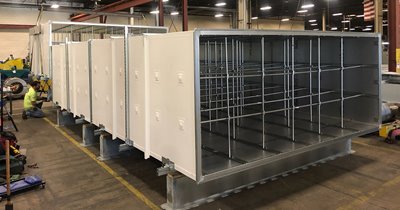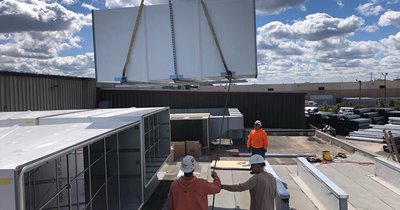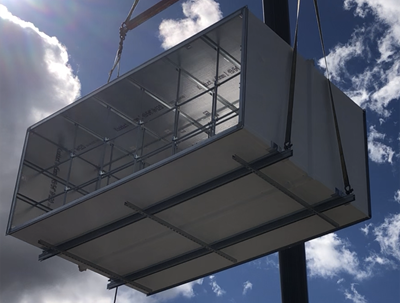
A large manufacturing company in Harvey, Illinois, needed 170 feet of R-12 Thermaduct with dimensions of 148 inches by 60 inches. Sheet Metal Werks had to lift and install the pieces onto a rooftop feeding two air units.
In this industry, we all know that time is money. Finding ways to think outside the box and reduce man-hours is the key to profitability — and happy clients. Sheet Metal Werks, a full-service fabricator in Arlington Heights, Illinois, recently demonstrated how pre-planning can make a world of difference.
The scope of the project consisted of approximately 170 feet of R-12 Thermaduct with dimensions of 148 inches by 60 inches. The Thermaduct was to be lifted and installed onto a rooftop feeding two make-up air units that would supply a large manufacturing company in Harvey, Illinois.
Given the size of this ductwork, this accomplishment was no small feat. But superintendent John Crne says that it all came back to doing more planning in the shop — as opposed to in the field where you’re working on a rooftop and out in the elements.
Logistically getting the material to the site initially led the company toward stacking it on flatbed trucks to save on shipping. But had the company stopped the thought process there, they would never have seen the tremendous back-end efficiency.

“We realized that if we put more coordination and planning into assembling ductwork and sending it in larger sections that the contractor would pay more upfront but really save on the back end,” Crne says. “Whenever you can coordinate and do more planning in the shop — where you’re working in a controlled environment — that’s a win.”
According to Crne, had they shipped ductwork to the site as initially planned, it would have required 29 crane picks—which they brought down to 12. Had they lifted individually, they would have had 27 connections to complete on the roof—which was brought down to only 10.
“Reducing the work in the field made this project turnkey,” continues Crne. “We did all the supports, the connections, and weatherproof covers. And we were able to eliminate the insulation subcontractor coming out after the installation. That three-hour window was from the time we hoisted the first section to the completion.”
Crne says that the lightweight material allowed them to land each section on a roof rail and then push and connect as they moved down the line. It was as streamlined as a project can get. The total weight of the Thermaduct was only 1,900 pounds versus 5,400 pounds if it were to be done in Galvanized metal.

“We really put a lot of emphasis on upfront coordination and planning with the customer,” Crne says. “We’re looking at how we can save the end user time and money, as well as make them more profitable. When the contractor is more profitable, so are we.”
In this case, the installing contractor was Midwest Mechanical — a company that Sheet Metal Werks has partnered with for decades. A good working relationship with the contractor is always critical, adds Crne.
“I would say that the spooling of the material was a key to the success of this project,” Crne says. “The Thermaduct had built-in lifting lugs, fully sealed connections, as well as all the struts and supports that would usually be installed in the field. Because it was so lightweight, they slid onto the rails easily and then it was a drop-and-go situation. There was no circling back. We finished each section as we went, which really streamlined the entire process.”
This was also a result of forethought and planning, with the spacing of the roof rails kept just right to keep things moving.
“It all comes back to the fact that we were focused on taking away field labor hours wherever we could,” Crne says. “By moving those field labor hours into the shop, it’s always more productive and efficient. Had we not planned, and the roof rails were not spaced in a way that helped pull the connections, we would have added time back into the field.”
Crne says that the best lesson to come out of this project is that pre-planning and coordination are worth the effort. Any time you can add upfront cost to save on the back end of a project is always going to be more profitable for the contractor.
“I have been with Sheet Metal Werks for over 20 years and have witnessed firsthand how much our industry has changed,” he sums up. “This Thermaduct project was a great example of how we can truly shift those field hours into the shop. This is something we take great pride in, which ultimately makes our contractors more competitive, as well as continuing to help streamline project completion.”